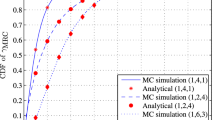Abstract
Antenna diversity is an important technique to combat fading and reduce co‐channel interference (CCI). In this paper, we present an analytical approach to derive bit error rate (BER) for Optimum Combining (OC) and Maximal Ratio Combining (MRC) in the presence of CCI. The paper has two parts. In the first part, the analysis of BER for OC with two co‐channel interferers and MRC with an arbitrary number of interferers is presented for M‐array antenna systems under the assumption that the channels of users are independent of each other. In the second part, the analysis of BER for OC and MRC in the presence of one dominant co‐channel interferer is presented for dual antenna systems by assuming that the channels of the desired user or co‐channel interferer are correlated. For DPSK signal, an exact BER expression is derived. The work presented here also yields an upper bound for BPSK or QAM signal based on the results of Foschini and Salz (1983).
Similar content being viewed by others
References
B. Baidyanathan and M.D. Srinath, Dual polarized smart antenna beams, in: Proceedings of VTC '96, Atlanta, GA (April 28- May 1, 1996) pp. 1675–1679.
[2] V.M. Bogachev and I.G. Kiselev, Optimum combining of signals in space-diversity reception, Telecommunications and Radio Engineering 34/35(10) (1980) 83–85.
G.E. Bottomley and K. Jamal, Adaptive array and MLSE equalization, in: Proceedings of VTC '95, Chicago, Illinois (July 25- 28, 1995) pp. 50–54.
R.T. Compton, Adaptive Antenna - Concepts and Performance (Prentice-Hall, Englewood Cliffs, NJ, 1988).
J. Cui, D.D. Falconer and A.U.H. Sheikh, The analysis of BER for optimum combining with two co-channel interferers and maximal ratio combining with arbitrary number of interferers, in: Proceedings of PIMRC '96, Taipei, Taiwan (October 15- 18, 1996) pp. 53–57.
J. Cui, D.D. Falconer and A.U.H. Sheikh, BER analysis of optimum combining and maximal ratio combining with channel correlation for dual antenna systems, in: Proceedings of VTC '97, Phoenix, Arizona (May 5- 7, 1997) pp. 150–154.
W.B. Davenport and W.L. Root, An Introduction to the Theory of Random Signals and Noise (McGraw-Hill, New York, 1958).
G.J. Foschini and J. Salz, Digital communications over fading radio channels, Bell System Technical Journal 62 (February 1983) 429–456.
W.C. Jakes Jr. et al., Microwave Mobile Communications (Wiley, New York, 1974).
R.O. LaMaire and M. Zorzi, Correlation in diversity systems with Raleigh fading, shadowing, and power capture, in: Proceedings of PIMRC '95, Toronto, Canada (September 27- 29, 1995) pp. 1212–1217.
R.J. Muirhead, Aspects of Multivariate Statistical Theory (Wiley, New York, 1982).
W. Refai and S.C. Gupta, Effect of correlation on a mobile radio maximal ratio diversity combiner for CPM with multiple interference signal, in: Proceedings of VTC '89, San Francisco, California (May 1- 3, 1989) pp. 452–456.
J. Salz and J.H. Winters, Effect of fading correlation on adaptive arrays in digital wireless communications, IEEE Trans. Vehicular Technol. 43(4) (1994) 1049–1057.
A.M.D. Turkmani et al., An experimental evaluation of the performance of two-branch space and polarization diversity schemes at 1800 MHz, IEEE Trans. Vehicular Technol. 44(2) (May 1995) 318–326.
Y. Wan and J.C. Chen, Fading distribution of diversity techniques with correlated channels, in: Proceedings of PIMRC '95, Toronto, Canada (September 27- 29, 1995) pp. 1202–1206.
WD2-adaptive antenna: measurements and field trials, in: Proceedings VTC '97 Arizona, Vehicular Technology Conference session (May 5- 7, 1997) pp. 1572–1597.
J.H. Winters, Optimum combining in digital mobile radio with co-channel interference, IEEE Trans. Vehicular Technol. 33(3) (1984) 144–155.
J.H. Winters and J. Salz, Upper bounds on the bit error rate of optimum combining in wireless systems, in: Proceedings of VTC '94, Stockholm, Sweden (June 8- 10, 1994) pp. 942–946.
Author information
Authors and Affiliations
Rights and permissions
About this article
Cite this article
Cui, J., Falconer, D.D. & Sheikh, A.U. Performance evaluation of optimum combining and maximal ratio combining in the presence of co‐channel interference and channel correlation for wireless communication systems. Mobile Networks and Applications 2, 315–324 (1997). https://doi.org/10.1023/A:1013653321510
Issue Date:
DOI: https://doi.org/10.1023/A:1013653321510




